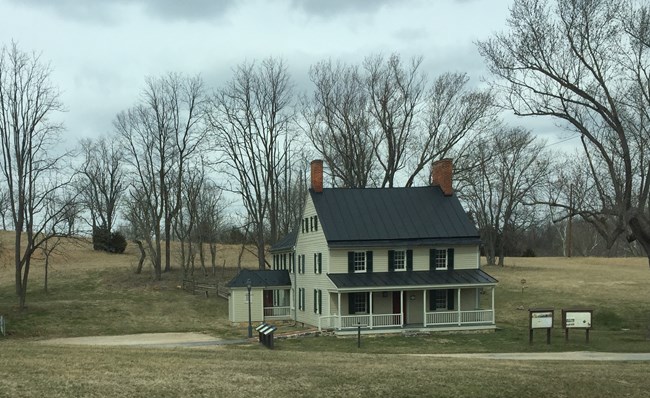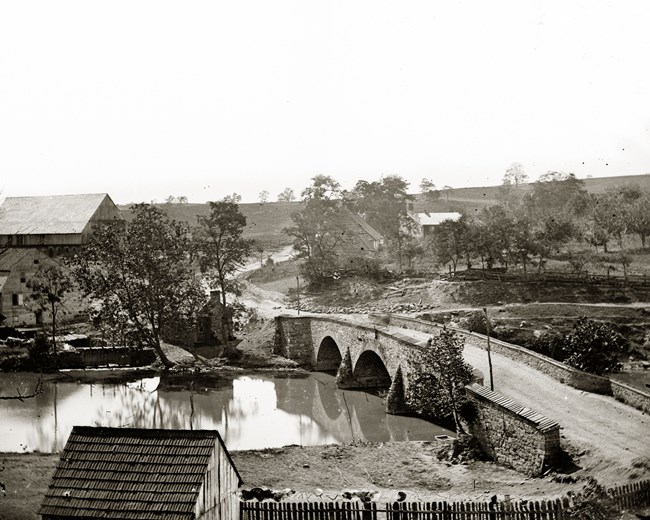The Newcomer Family and FarmsteadJoshua Newcomer and his wife had seven children and lived on the west bank of the Antietam Creek. They owned a sizable portion of land and ran a prosperous farm and industrial complex along the main road from Frederick to Sharpsburg. The Newcomer’s had no idea that the fall of 1862 would bring war, death, and destruction to their doorsteps. 
NPS Antietam Photo Historical Ownership and Structural ChangesIn 1762, Christian Orndorff, a settler from Pennsylvania, purchased 512 acres near the Antietam Creek, and began developing the property that would be later known as the Newcomer farm. He called the tract “Mount Pleasant.” Orndorff built a large three-story home and barn. He also constructed a grist mill, sawmill, and plaster mill along the Antietam Creek. The mills were powered by the seemingly endless flow of creek water. During his ownership, Orndorff expanded the complex to include several workshops and a cooper shop. The property bordered the main thoroughfare connecting Frederick and Sharpsburg and became a center for commerce. Local farmers brought their grain to the mill to be processed and turned into flour for personal use and sale. In 1786 Christian Orndorff transferred the milling business to his son Christopher, who continued developing the property. He constructed a home not far from his fathers, and this is the structure that we recognize today as the Newcomer house. Christian continued running the milling operation until the early 19th century, when it was purchased by the Mumma family. The property changed hands several times from 1806 to 1853, when Joshua Newcomer purchased 156 acres of the land formerly known as Mount Pleasant . For almost a decade, the Newcomer family enjoyed the tranquility of the Antietam Valley, before war shattered their peaceful existence . 
Library of Congress The Battle of AntietamConfederate and Union forces began arriving in the Sharpsburg area following the battle of South Mountain on September 15th. There were skirmishes on and around the Newcomer property as Union forces tried to secure the Middle Bridge. Captain John C. Tidball of Battery A of the Second U.S. Artillery described the cannonade near the bridge on the 15th in his after action report: “In a few minutes they opened a fire of Artillery; upon which I brought my pieces into position, on the crest of the hill to the right of the road, and fired in reply”.i Tidball recalled that the exchange of fire began around noon and persisted until dark that evening. Skirmishes continued on the 16th, and as the day came to a close nearly 100,000 soldiers settled down for a restless night of sleep knowing that battle was eminent. At dawn on September 17th, shots rang out breaking the morning calm as Union soldiers left the cover of the North Woods and moved into a field of corn ready for harvest. Union soldiers attacked south through the Cornfield encountering Confederate infantry and artillery fire from Nicodemus Heights and the Dunker Church plateau. A soldier from the First Texas described the Cornfield as, “the hottest place I ever saw on this earth or want to see hereafter. There were shot, shells, and Minie balls sweeping the face of the earth; legs, arms, and other parts of human bodies were flying in the air like straw in a whirlwind. The dogs of war were loose, and ‘havoc’ was their cry.” Around 9:30, Union forces continued moving south, and fought Confederate forces under D.H Hill in the Sunken Road. At 10:00, a cannonade erupted near the Newcomer property, as General Fitz John Porter ordered the Fifth Corps to advance. Captain Tidball recalled the events in his after action report: I was ordered to cross the turnpike bridge over the Antietam where I took position on the right of the road. In front the enemy's Sharpshooters were posted and there being no infantry at hand to drive them back, I opened fire upon them with Canister, and gradually worked my guns by hand up a steep ploughed field to the crest of the hill where I placed them in a commanding position not only for the enemy directly in front, but for an enfilading fire in front of Sumner's Corps on the right and that of Burnside on the left of me. The enemy's batteries all the while were very active, but with some exception his practice was bad.... On the 17th I had one private--Hitz killed, and one severely and two slightly wounded and 10 horses killed. I fired in all about 1,200 rounds. The Fifth Corps advanced across the Middle Bridge pushing Confederate forces back and successfully occupied the high ground, moving to the outskirts of Sharpsburg by day’s end. After twelve grueling hours, the Battle of Antietam was over. Twenty-three thousand soldiers were missing or had been wounded or killed. Aftermath and PreservationIn the wake of the battle, the Newcomer house, barn, and mill, like many of the structures surrounding the battlefield, became a field hospital for wounded soldiers. Several days after the battle, a photographer named Alexander Gardner visited Sharpsburg and took photographs of the devastation. He Newcomer property is featured in several photographs. Gardner captured the Middle Bridge, the original Orndorff home, and several out buildings of the mill complex. The Newcomer family returned to their home to find that they had not been spared from the destructive storm of battle. Joshua Newcomer submitted a claim to the United States government requesting compensation for the damage done to his property, On or about 17th day of September 1862 a portion of the U.S. (Army) under the command of General Porter (V Corps) encamped on and near said farm, and on the four days immediately succeeding said battle appropriated for their immediate use a large quantity of his property including 4,964 fence rails, 28 panels of board fence, 42 panels of board fence 16 feet long, 1 sorrel horse, 18 acres of corn and fodder, and the uncut hay on 77 acres of pasture land.ii The Newcomers claim amounted to over $3,000 dollars in damages. However, they only received $145 dollars as compensation because it was apparently unclear whether Union or Confederates caused the damage. The Newcomers crops and property were devastated during the fall of 1862, and they never recovered financially . The family left the Sharpsburg area for a time and eventually returned to Maryland and settled in Clear Spring. The milling complex changed hands several times and operated until the late 1880s. After nearly a century, the milling operation along Antietam Creek was shuttered, but its story continues. The only structures that remain on the Newcomer property are the house and barn; Maryland Route 34 divides the property in half. The National Park Service acquired the barn in 2003, and it was restored in 2014. A private owner restored the Newcomer house in 2000, and the National Park Service purchased the structure in 2007. In 2010, the Newcomer house opened to the public through a partnership between the National Park Service, the Heart of the Civil War Heritage Area, and the Hagerstown-Washington County Convention and Visitors Bureau, as a visitor center. Here, you can find information on Civil War sites in the Heritage area which spans three counties, peruse exhibits, and participate in monthly programming. You can find out more about special programs by visiting this website: http://www.heartofthecivilwar.org/newcomer-house. You can be a part of the Newcomer story by visiting the historic farmstead and enjoying a peaceful walk along Antietam Creek, imagining a time when peace was no where to be found. 
NPS Antietam / K.Snyder |
Last updated: September 15, 2023
